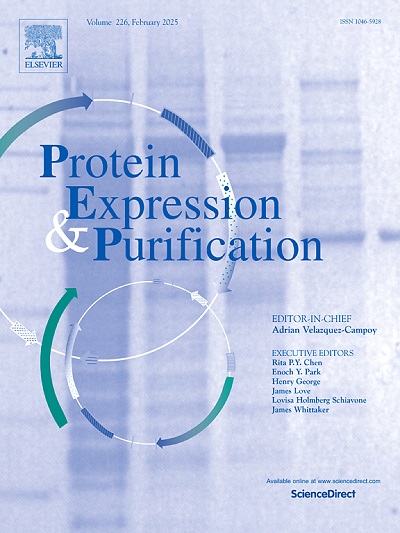Strategies for generating soluble and monomeric samples of Ycf1p NBD2
IF 1.2
4区 生物学
Q4 BIOCHEMICAL RESEARCH METHODS
引用次数: 0
Abstract
The yeast cadmium factor 1 protein (Ycf1p) is an ATP-binding cassette (ABC) transporter that is located in the vacuolar membrane and is responsible for transporting glutathione-conjugated metals from the cytoplasm into the vacuole. Ycf1p contains the ABC core structure of two transmembrane domains (TMD1, TMD2) and two nucleotide-binding domains (NBD1, NBD2). As a member of the C-subfamily of ABC proteins (ABCC), Ycf1p also contains an N-terminal extension comprised of an additional TMD (TMD0) and L0 linker. Although high-resolution structures of many ABC transporters have been determined, the NBDs can be at low resolution in cryo-EM maps. Thus, studies of the isolated cytosolic NBDs are crucial for obtaining molecular-level details of the dynamics of these catalytic entities, for example. In this study, we present a scheme for obtaining samples of NBD2 from the yeast cadmium factor 1 protein (Ycf1p) in a soluble, monomeric, and functional form. While production of NBD1 from Ycf1p and other ABC proteins has been accomplished, generating samples of NBD2 from different ABC proteins has been elusive for the most part, particularly for ABCC proteins. We show that NBD2 preparation necessitates minimizing dimerization and aggregation of the protein at multiple steps during the purification, which is accomplished by employing a solubility tag, eliminating nucleotides from the buffers, and limiting the duration of spin concentrating steps. This work lays the foundation for detailed studies of Ycf1p NBD2 and provides an outline for optimizing the generation of samples of NBD2 from other ABC proteins.
生成Ycf1p NBD2可溶性和单体样品的策略
酵母镉因子1蛋白(Ycf1p)是一种atp结合盒(ABC)转运蛋白,位于液泡膜上,负责将谷胱甘肽结合的金属从细胞质转运到液泡中。Ycf1p含有两个跨膜结构域(TMD1、TMD2)和两个核苷酸结合结构域(NBD1、NBD2)的ABC核心结构。作为ABC蛋白c亚家族(ABCC)的成员,Ycf1p还含有一个n端延伸,由一个额外的TMD (TMD0)和L0连接子组成。虽然许多ABC转运体的高分辨率结构已经确定,但在低温电镜图中,nbd可能是低分辨率的。因此,对分离胞质nbd的研究对于获得这些催化实体的分子水平动力学细节至关重要。在这项研究中,我们提出了一种从酵母镉因子1蛋白(Ycf1p)中以可溶性、单体和功能形式获得NBD2样品的方案。虽然从Ycf1p和其他ABC蛋白中产生NBD1已经完成,但从不同的ABC蛋白中产生NBD2的样品在很大程度上是难以捉摸的,特别是对于ABCC蛋白。我们发现NBD2的制备需要在纯化过程中的多个步骤中尽量减少蛋白质的二聚化和聚集,这是通过使用溶解度标签,从缓冲液中去除核苷酸,并限制自旋浓缩步骤的持续时间来完成的。这项工作为Ycf1p NBD2的详细研究奠定了基础,并为优化从其他ABC蛋白中生成NBD2样品提供了大纲。
本文章由计算机程序翻译,如有差异,请以英文原文为准。
求助全文
约1分钟内获得全文
求助全文
来源期刊

Protein expression and purification
生物-生化研究方法
CiteScore
3.70
自引率
6.20%
发文量
120
审稿时长
32 days
期刊介绍:
Protein Expression and Purification is an international journal providing a forum for the dissemination of new information on protein expression, extraction, purification, characterization, and/or applications using conventional biochemical and/or modern molecular biological approaches and methods, which are of broad interest to the field. The journal does not typically publish repetitive examples of protein expression and purification involving standard, well-established, methods. However, exceptions might include studies on important and/or difficult to express and/or purify proteins and/or studies that include extensive protein characterization, which provide new, previously unpublished information.
 求助内容:
求助内容: 应助结果提醒方式:
应助结果提醒方式:


